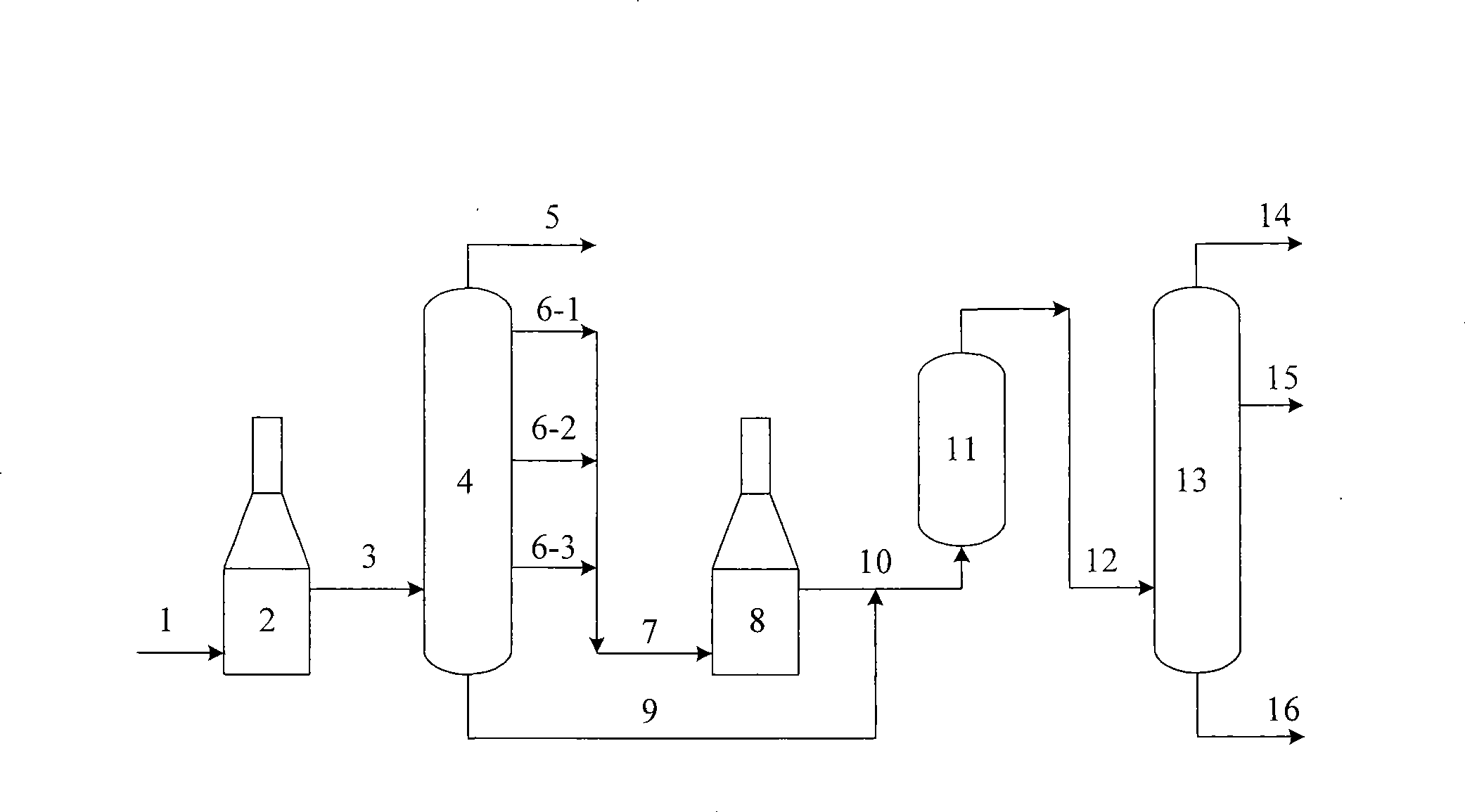Viscosity breaking method
A technology for visbreaking and vacuum distillate oil, which is used in cracking, non-catalytic thermal cracking, petroleum industry, etc., can solve problems such as large investment and operating costs, and achieve good stability, increased yield, and reduced viscosity. Effect
- Summary
- Abstract
- Description
- Claims
- Application Information
AI Technical Summary
Problems solved by technology
Method used
Image
Examples
Embodiment 1
[0037] The raw material for visbreaking is atmospheric residue, that is, the density at 20°C is 0.9914g / cm 3 , the kinematic viscosity at 100°C is 304.5mm 2 / s, the residual carbon is 16.6% by weight, the freezing point is 25°C, the sulfur content is 2.51% by weight, and the asphaltene content is 10.9% by weight.
[0038] according to figure 1 The scheme shown carries out the visbreaking process of the present invention.
[0039] (1) vacuum distillation
[0040] The atmospheric residue 1 is heated to 390°C in the vacuum distillation heating furnace 2, and then enters the vacuum distillation tower 4 with a top absolute pressure of 1.8kPa through the pipeline 3 for vacuum distillation, respectively on the vacuum distillation tower, The side line 6-1, side line 6-2 and side line 6-3 in the middle and lower part distill vacuum distillate oil, and the distillation range of the mixture of the three side line distillate vacuum distillate oils is 335-598°C. The bottom of the tower...
Embodiment 2
[0055] The same atmospheric residue as in Example 1 was used as the raw material for visbreaking. according to figure 1 The scheme shown performs visbreaking.
[0056] (1) vacuum distillation
[0057] The atmospheric residue 1 is heated to 420°C in the vacuum distillation heating furnace 2, and then enters the vacuum distillation tower 4 with a top absolute pressure of 5.3kPa through the pipeline 3 for vacuum distillation, respectively on the vacuum distillation tower, The side line 6-1, side line 6-2 and side line 6-3 in the middle and lower part distill vacuum distillate oil, and the distillation range of the vacuum distillate oil mixture of the three side lines is 318-567 ° C. Vacuum residue oil above 540°C is extracted from the bottom of the pump. The vacuum distillation column top line 5 goes to the vacuum system.
[0058] (2) Visbreaking
[0059] The vacuum distillate mixture of the vacuum distillation tower side lines 6-1, 6-2 and 6-3 enters the visbreaking heating...
Embodiment 3
[0063] The same atmospheric residue as in Example 1 was used as the raw material for visbreaking. according to figure 1 The scheme shown performs visbreaking.
[0064] (1) vacuum distillation
[0065]The atmospheric residue 1 is heated to 410°C in the vacuum distillation heating furnace 2, and then enters the vacuum distillation tower 4 with a top absolute pressure of 3.0kPa through the pipeline 3 to carry out vacuum distillation, respectively on the vacuum distillation tower, The side line 6-1, side line 6-2 and side line 6-3 in the middle and lower part distill vacuum distillate oil, and the distillation range of the vacuum distillate oil mixture of the three side lines is 331-588 ° C. In the vacuum distillation tower Vacuum residue oil above 550°C is extracted from the bottom of the pump. The vacuum distillation column top line 5 goes to the vacuum system.
[0066] (2) Visbreaking
[0067] The vacuum distillate mixture of the vacuum side lines 6-1, 6-2 and 6-3 enters t...
PUM
| Property | Measurement | Unit |
|---|---|---|
| Density | aaaaa | aaaaa |
| Kinematic viscosity | aaaaa | aaaaa |
| Solidifying point | aaaaa | aaaaa |
Abstract
Description
Claims
Application Information
 Login to View More
Login to View More - R&D
- Intellectual Property
- Life Sciences
- Materials
- Tech Scout
- Unparalleled Data Quality
- Higher Quality Content
- 60% Fewer Hallucinations
Browse by: Latest US Patents, China's latest patents, Technical Efficacy Thesaurus, Application Domain, Technology Topic, Popular Technical Reports.
© 2025 PatSnap. All rights reserved.Legal|Privacy policy|Modern Slavery Act Transparency Statement|Sitemap|About US| Contact US: help@patsnap.com

